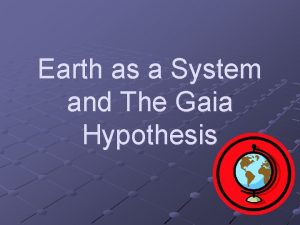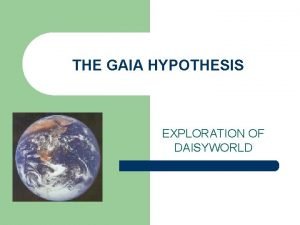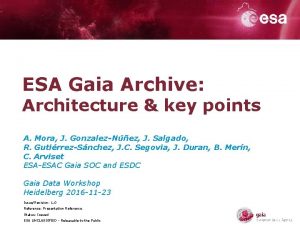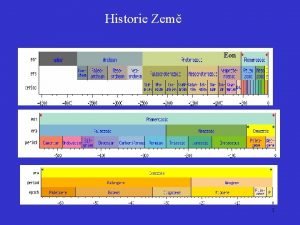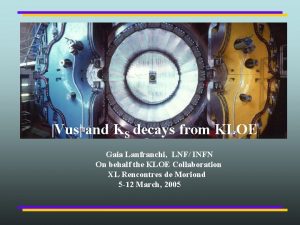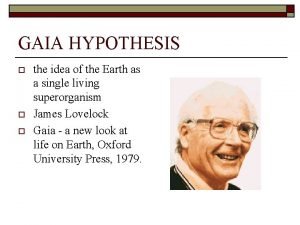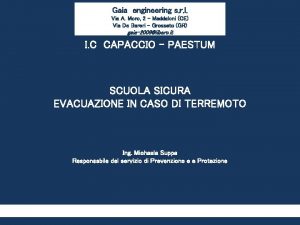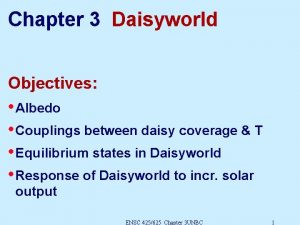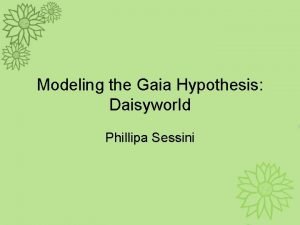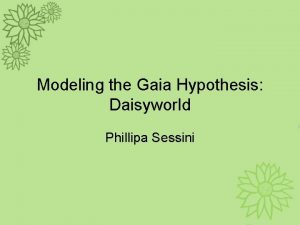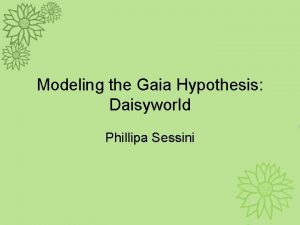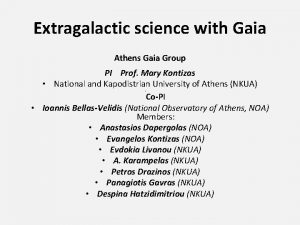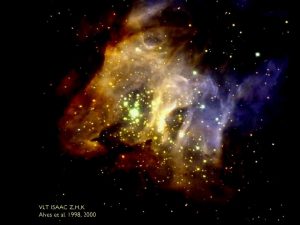Daisyworld Daisy World Gaia Theory the world is



















































- Slides: 51

Daisyworld

Daisy World

Gaia Theory: the world is a strongly interacting system William Golding – Nobel laureate Oxford physics undergraduate James Lovelock – inventor of electron capture detector and daisyworld

Lovelock’s Questions James Lovelock: NASA atmospheric chemist analyzing distant Martian atmosphere. Why has temp of Earth’s surface remained in narrow range for last 3. 6 billion years when heat of sun has increased by 25%?

Faint sun paradox

Our Earth is a Unique Planet in the Solar System source: Guy Brasseur (CSC/Germany) Runaway greenhouse : : No water cycle to remove carbon from atmosphere Earth Harbor of Life Loss of carbon : : No lithosphere motion on Mars to release carbon Look again at that pale blue dot. That’s here. That’s home. That’s us. (Carl Sagan)

Lovelock’s Questions Why has oxygen remained near 21%? Martian atmosphere in chemical equilibrium, whereas Earth’s atmosphere in unnatural low-entropy state.

Main idea • Lovelock began to think that such an unlikely combination of gases such as the Earth had, indicated a homeostatic control of the Earth biosphere to maintain environmental conditions conducive for life, in a sort of cybernetic feedback loop, an active (but non-teleological) control system.

The athmosphere as a dynamic system • • A lifeless planet would have an atmospheric composition determined by physics and chemistry alone, and be close to an equilibrium state. The atmosphere of a planet with life would depart from a purely chemical and physical equilibrium as life would use the atmosphere as a ready source, depository and transporter of raw materials and waste products

Mars and Venus • • • Both planets, based on spectroscopic methods, have atmospheres dominated by CO 2 and are close to chemical equilibrium. Differences in temperature and their atmospheres are related to distances from sun. No evidence of atmospheric imbalances on these planets to indicate the presence of life.

Lovelock´s answers Earth can’t be understood without considering the role of life Abiotic factors determine biological possibilities Increased Planetary Temperature Sparser Vegetation, More Desertification Biotic factors feed back to control abiotic factors Increased Planetary Albedo Reduced Planetary Temperature

Gaia Hypothesis Organisms have a significant influence on their environment Species of organisms that affect environment in a way to optimize their fitness leave more of the same – compare with natural selection. Life and environment evolve as a single system – not only the species evolve, but the environment that favors the dominant species is sustained

Gaia Hypothesis Influential Gaia Life collectively has a significant effect on earth’s environment Goes beyond simple interactions amongst biotic and abiotic factors Optimizing Gaia Life optimizes the abiotic environment to best meet biosphere’s needs Homeostatic Gaia Atmosphere-Biosphere interactions are Dominated by negative feedback Coevolutionary Gaia Evolution of life and Evolution of its environment are intertwined Geophysiological Gaia Biosphere can be modeled as a single giant organism

Example: ATMOSPHERE • • "Life, or the biosphere, regulates or maintains the climate and the atmospheric composition at an optimum for itself. “ Loveland states that our atmosphere can be considered to be “like the fur of a cat and shell of a snail, not living but made by living cells so as to protect them against the environment”.


What is Albedo? The fraction of sunlight that is reflected back out to space. Earth’s average albedo for March 2005 NASA image http: //visibleearth. nasa. gov/view_rec. php? id=17177


source: Youmin Tang (UNBC)

Why is albedo higher at the poles and lower at the equator? High Choose the correct answer: A. Because more sunlight hits at the equator than the poles. Because snow and ice at the poles reflects more sunlight. C. Because higher temperatures at the equator Low High



Daisyworld A planet with dark soil, white daisies, and a sun shining on it. The dark soil has low albedo – it absorbs solar energy, warming the planet. The white daisies have high albedo – they reflect solar energy, cooling the planet.

The number of daisies affects temperature The number of daisies influences temperature of Daisyworld. More white daisies means a cooler planet.

Temperature affects the number of daisies At 25° C many daisies cover the planet. Daisies can’t survive below 5° C or above 40° C.

Intersection of 2 curves means the 2 effects are balanced => equilibrium points P 1 & P 2. Daisy coverage Effects of daisy coverage on T P 1 Effects of T on daisy coverage P 2 T source: Youmin Tang (UNBC)

Daisy coverage Perturb daisy coverage at P 1 => system returns to P 1 (stable equilibrium point) P 1 A large perturbation => daisies all die from extreme T P 2 T source: Youmin Tang (UNBC)

Daisy coverage Large increase in daisy cover => very low T => decrease in daisy cover => very high T => lifeless. P 1 P 2 T source: Youmin Tang (UNBC)

Daisy coverage From P 2, increase daisy coverage => decrease T => further increase in daisy coverage => converge to P 1 P 2 unstable equilibrium point T source: Youmin Tang (UNBC)

Gradual increase in solar luminosity Daisy coverage For all values of daisy coverage, T increases P 1 The effect of T on Daisy unchanged P 1 P 2 To Teq Tf P 2 T source: Youmin Tang (UNBC)

Daisy World – two species

Daisyworld with two species of daisies Figure 1: Equal numbers of white and black daisies. Temperature is 'normal'. Figure 2: Mostly black daisies - temperature is consequently high. Figure 3: Mostly white daisies - temperature is low. Source: Jeffrey Smith (UGA)

Daisyworld Experiment Seed the planet with a mix of light and dark daisies, and then slowly increase the luminosity (light reaching the planet). This is not unlike the case for Earth, since the sun's luminosity has increased gradually about 30% over 4. 6 Ga.

Daisyworld as a feedback system + source: Andrew Ford

Daisyworld equilibrium conditions source: Andrew Ford

Temperature Control on Daisyworld

Daisyworld simulation • • • First, run the model long enough for Daisyworld temperature to reach equilibrium Then, apply a sudden change in solar input Observe how Daisyworld reacts to restore its temperature Source: Jeffrey Smith (UGA)

When Daisyworld is cool… Air temperature over the black patches is higher Black patches grow more Overall planet color becomes darker Planet albedo decreases Source: Jeffrey Smith (UGA)

When Daisyworld is cool… • • • Planet absorbs more sunlight and gets warmer Daisies have altered the climate! Daisyworld temperature is closer to optimal temperature for daisies!

When Daisyworld is warm… Air temperature over the black patches is higher White patches grow more Overall planet color becomes lighter Planet albedo increases

The key variables

Equation for the black daisies dαb/dt = αb ( 1 – αb – αw) β(Tb) - γαb = αb (αg β(Tb) – γ) β(T) is a function that is zero at 50 C, rises to a maximum of one at 22. 50 C and then falls to zero again at 400 C A convenient choice is

Equation for the white daisies We use a similar equation for the white daisies: dαw/dt = αw (αg β(Tw) – γ) We don’t have to use the same b(T) and g but it keeps things simple. We can use different ones later if we want to.

Energy balance Energy arrives on Daisyworld at a rate SL(1 -A) where L is the solar luminosity, S is a constant and A is the mean reflectivity Daisyworld radiates energy into space at a rate s: Stephan’s constant T: the ‘effective’ temperature. Energy in must equal energy out, and so we have

Heat Flow Because different regions of Daisyworld are at different temperatures, there will be heat flow. We include this in the model using the equations Note that if q=0 the whole planet is at the same temperature, i. e. , the heat flow is very rapid indeed. As q increases, so do the temperature differences.

The Daisyworld Equations

The Daisyworld Equations

Daisyworld Model (3) • Area of daisies is modified according to the following equations

Temperature as a function of luminosity

Daisyworld results: planet temperature x solar luminosity

Daisyworld results: daisy percentage x average solar luminosity

Effects of Solar Luminosity on 2 D Daisyworld Phillipa Sessini (Toronto) 0. 7 0. 8 1. 1 1. 2 0. 9 1. 3 1. 0 1. 4
 Daisyworld model report with illustration
Daisyworld model report with illustration Daisyworld
Daisyworld Gaia principle
Gaia principle The gaia hypothesis
The gaia hypothesis Gaia second wire
Gaia second wire Gaia technologies plc
Gaia technologies plc Filastrocca corta e gaia
Filastrocca corta e gaia Gaia fund
Gaia fund Titanomach
Titanomach Csr gaia control
Csr gaia control 11. gaia diktadura frankista euskal herrian
11. gaia diktadura frankista euskal herrian Gaia narciso
Gaia narciso Gaia and uranus family tree
Gaia and uranus family tree Gaia expediciones
Gaia expediciones Gaia expediciones
Gaia expediciones Gaia archive
Gaia archive Gaia edr
Gaia edr Cluster gaia
Cluster gaia Gaia adie
Gaia adie Gaia and ouranos
Gaia and ouranos Gaia green all purpose 4-4-4
Gaia green all purpose 4-4-4 Griechische göttin erde
Griechische göttin erde Gaia
Gaia Gaia lanfranchi
Gaia lanfranchi Les 12 titans mythologie grecque
Les 12 titans mythologie grecque Kurose ross computer networking
Kurose ross computer networking Gaia hernandez
Gaia hernandez Gaia hypothesis examples
Gaia hypothesis examples Ljiljana moro
Ljiljana moro Telnet gaia.cs.umass.edu 80
Telnet gaia.cs.umass.edu 80 Que es gaia segun mago de oz
Que es gaia segun mago de oz Gaia grid
Gaia grid How is tom careless in the great gatsby
How is tom careless in the great gatsby How did daisy react after gatsby left for military service
How did daisy react after gatsby left for military service Motifs in the great gatsby
Motifs in the great gatsby Map of west and east egg
Map of west and east egg Chapter 8 summary great gatsby
Chapter 8 summary great gatsby The great gatsby ch 8 summary
The great gatsby ch 8 summary What is justice
What is justice Ashesn
Ashesn Bus interconnection in computer architecture
Bus interconnection in computer architecture Setting of daisy miller
Setting of daisy miller Columbines symbolism
Columbines symbolism Why does tom insist daisy go home with gatsby
Why does tom insist daisy go home with gatsby Three symbols in the great gatsby
Three symbols in the great gatsby Is a gerber daisy vascular or nonvascular
Is a gerber daisy vascular or nonvascular Topologi daisy chain
Topologi daisy chain Gatsby's actions in preparing for daisy's arrival
Gatsby's actions in preparing for daisy's arrival I hate careless people thats why i like you
I hate careless people thats why i like you Daisy destruction
Daisy destruction Daisy head colony of corynebacterium
Daisy head colony of corynebacterium Great gatsby protagonist
Great gatsby protagonist


